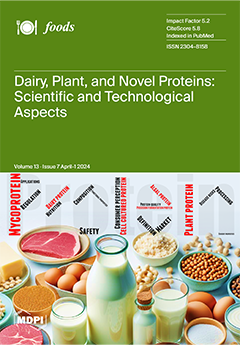Mesona chinensis, in Thai called Chao Kuay and in Chinese Hsian-tsao, belongs to the Lamiaceae family. This herbal plant grows widely in Southern China, Taiwan (China), Malaysia, the Philippines, Indonesia, Vietnam, and Thailand. The Mesona plant is used to make functional products
[...] Read more.
Mesona chinensis, in Thai called Chao Kuay and in Chinese Hsian-tsao, belongs to the Lamiaceae family. This herbal plant grows widely in Southern China, Taiwan (China), Malaysia, the Philippines, Indonesia, Vietnam, and Thailand. The Mesona plant is used to make functional products such as drinks and soft textured sweet treats, and also traditional medicine, to treat heat stroke, high blood pressure, heart attack, high blood sugar, hepatic diseases, colon diseases, inflammatory conditions, and to alleviate myalgia. The proximate composition of
M. chinensis is a mixture of protein, fat, fiber, ash, and minerals. The main biological compounds in
M. chinensis extracts are polysaccharides, terpenoids, flavonoids, and polyphenols, with wide-ranging pharmacological properties including antioxidant, antidiabetic, antilipidemic, carcinoma-inhibitory, renal-protective, antihypertensive, DNA damage-protective, and anti-inflammatory effects. This review investigated the proximate composition, polysaccharide type, and pharmacological properties of
M. chinensis extracts. Phytochemical properties enhance the actions of the gut microbiota and improve health benefits. This review assessed the functional and medicinal activities of
M. chinensis extracts. Future studies should further elucidate the in vitro/in vivo mechanisms of this plant extract and its impact on gut health.
Full article






